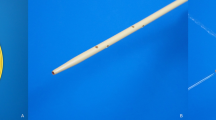Abstract
Background and aims
Cholelithiasis is the most common biliary tract disorder. Surgery is the treatment of choice for symptomatic gallstones. Aims of this study were to investigate the feasibility and short-term safety of a new endoscopic procedure with a specially designed Nitinol gallbladder stent for blockage of gallstone migration, the Shai™ Stent. The Shai stent is designed to enable free bile flow, which will be supposed to prevent recurrent attacks.
Methods
The Shai™ Stent was inserted into the gallbladder during a standard ERCP procedure using a conventional metal stent delivery system. The aim of the present study was to investigate the feasibility and safety of insertion and deployment and removal of the stent into the gallbladder of pigs. In addition, the short-term safety of the stent was evaluated.
Results
Fifteen stents were placed in the gallbladder of 15 pigs. Mean procedure time was 25 min (15–37). The maximum follow-up before sacrifice was 42 days. The stent in 1 pig had migrated at the 42 days follow-up but there were no macroscopic changes in its gallbladder or other organs. The stent remained in place in the remaining 12 pigs at autopsy, and the gallbladder and bile ducts were macroscopically normal. Stent removal was easily done in two pigs immediately after placement.
Conclusions
Correct placement and removal of the Shai™ Stent in the gallbladder is safe and feasible in pigs. Further clinical trials are warranted to confirm these results and to effectively evaluate the capability of this stent as an innovative biotechnology to block gallstones from migration and impaction.








Similar content being viewed by others
References
Stinton LM, Shaffer EA (2012) Epidemiology of gallbladder disease: cholelithiasis and cancer. Gut Liver 6:172–187
Williams E, Beckingham I, El SG, Gurusamy K, Sturgess R, Webster G, Young T (2017) Updated guideline on the management of common bile duct stones (CBDS). Gut 66:765–782
Livingston EH, Rege RV (2004) A nationwide study of conversion from laparoscopic to open cholecystectomy. Am J Surg 188:205–211
Kama NA, Kologlu M, Doganay M, Reis E, Atli M, Dolapci M (2001) A risk score for conversion from laparoscopic to open cholecystectomy. Am J Surg 181:520–525
Rosen M, Brody F, Ponsky J (2002) Predictive factors for conversion of laparoscopic cholecystectomy. Am J Surg 184:254–258
Lee TH, Park DH, Lee SS, Seo DW, Park SH, Lee SK, Kim MH, Kim SJ (2011) Outcomes of endoscopic transpapillary gallbladder stenting for symptomatic gallbladder diseases: a multicenter prospective follow-up study. Endoscopy 43:702–708
Itoi T, Coelho-Prabhu N, Baron TH (2010) Endoscopic gallbladder drainage for management of acute cholecystitis. Gastrointest Endosc 71:1038–1045
Itoi T, Sofuni A, Itokawa F, Tsuchiya T, Kurihara T, Ishii K, Tsuji S, Ikeuchi N, Tsukamoto S, Takeuchi M, Kawai T, Moriyasu F (2008) Endoscopic transpapillary gallbladder drainage in patients with acute cholecystitis in whom percutaneous transhepatic approach is contraindicated or anatomically impossible (with video). Gastrointest Endosc 68:455–460
Naitoh I, Nakazawa T, Miyabe K, Mizoguchi K, Kimura M, Takeyama H, Joh T (2015) A cholecystocolonic fistula caused by penetration of a double-pigtail plastic stent after endoscopic transpapillary gallbladder stenting. Endoscopy 47:E399–E400
Sarwar A, Zhou L, Chakrala N, Brook OR, Weinstein JL, Rosen MP, Ahmed M (2017) The relevance of readmissions after common IR procedures: readmission rates and association with early mortality. J Vasc Interv Radiol 28:629
Ryozawa S, Fujita N, Irisawa A, Hirooka Y, Mine T (2017) Current status of interventional endoscopic ultrasound. Dig Endosc 29:559
Shaffer EA (2005) Epidemiology and risk factors for gallstone disease: has the paradigm changed in the 21st century? Curr Gastroenterol Rep 7:132–140
Kratzer W, Mason RA, Kachele V (1999) Prevalence of gallstones in sonographic surveys worldwide. J Clin Ultrasound 27:1–7
Author information
Authors and Affiliations
Corresponding author
Ethics declarations
Disclosures
Mr. Shmuel Ben Muvhar is the CEO of Lithiblock. On the 8th of April Dr. Ivo Boskoski won a research Grant from Apollo endosurgery and also a consultancy agreement was signed. Prof. Guido Costamagna, Dr. Andrea Tringali, Prof. Fred M. Konikoff, and Dr. Jonathan Tsehori have no conflicts of interest or financial ties to disclose.
Additional information
Publisher's Note
Springer Nature remains neutral with regard to jurisdictional claims in published maps and institutional affiliations.
Rights and permissions
About this article
Cite this article
Boškoski, I., Konikoff, F.M., Ben Muvhar, S. et al. A novel gallbladder umbrella stent (the Shai™ Stent) for prevention of stone migration and impaction: results on feasibility and short-term safety in a porcine model. Surg Endosc 33, 3050–3055 (2019). https://doi.org/10.1007/s00464-019-06993-7
Received:
Accepted:
Published:
Issue Date:
DOI: https://doi.org/10.1007/s00464-019-06993-7




